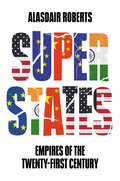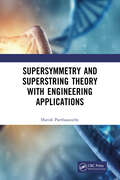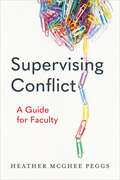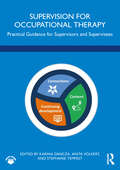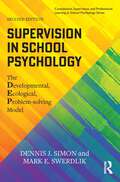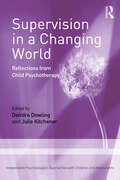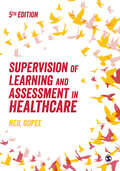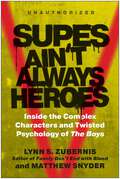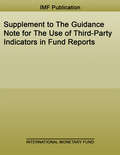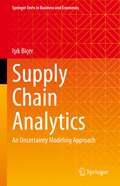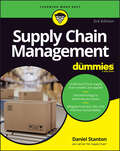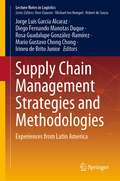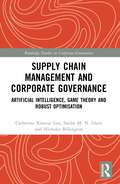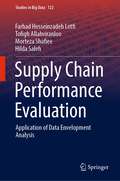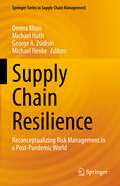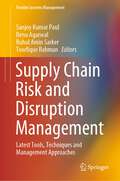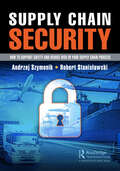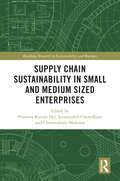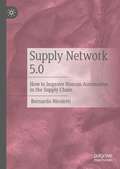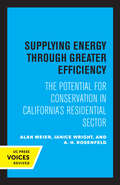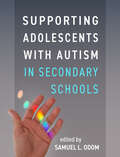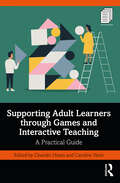- Table View
- List View
Superstates: Empires of the Twenty-First Century
by Alasdair RobertsIn this century, the world will conduct an extraordinary experiment in government. In 2050, forty percent of the planet's population will live in just four places: India, China, the European Union, and the United States. These are superstates – polities that are distinguished from normal countries by expansiveness, population, diversity, and complexity. How should superstates be governed? What must their leaders do to hold these immense polities together in the face of extraordinary strains and shocks? Alasdair Roberts looks to history for answers. Superstates, he contends, wrestle with the same problems of leadership, control, and purpose that plagued empires for centuries. But they also bear heavier burdens than empires – including the obligation to improve life for ordinary people and respect human rights. One axiom of history was that empires always died. Size and complexity led to fragility, and imperial rulers improvised constantly to put off the day of reckoning. Leaders of superstates are doing the same today, pursuing radically different strategies for governing at scale that have profound implications for democracy and human rights. History shows that there are ways to govern these sprawling and diverse polities well. But this requires a different way of thinking about the art and methods of statecraft.
Supersymmetry and Superstring Theory with Engineering Applications
by Harish ParthasarathyThis book introduces the vast subject of supersymmetry along with many specific examples of engineering applications, for example: • The design of quantum unitary gates using supersymmetric actions.• Bosonic and Fermionic noise in quantum systems using the Hudson-Parthasarathy quantum stochastic calculus.• Superstring theory applied to the quantum mechanics of neurons and supersymmetric quantum filtering theory which can, for example, be used to filter out the noise in a cavity resonator electromagnetic field produced by the presence electrons and positrons in a bath surrounding it.• Simplified versions of super-Yang-Mills theory with gauge and gaugino fields, both transforming under the adjoint representation of the gauge group and elementary super-gravity models have also been introduced. All through the book, emphasis is laid upon exploiting the supersymmetry existing in the nature of Boson-Fermion exchange in designing engineering systems like quantum computers and analyzing the performance of systems in the presence of supersymmetric quantum noise.
Supervising Conflict: A Guide for Faculty
by Heather PeggsCultivating respectful and productive academic relationships is a priority within higher education. What can faculty do when conflict disrupts research progress and strains the supervisor/student relationship? Supervising Conflict offers practical advice and tools to help faculty identify and actively respond to the most common grad school concerns – the "everyday" conflicts. Drawing on data collected over four years at a large research-intensive university in Canada, Heather McGhee Peggs provides faculty with a map to where issues are likely to emerge based on hundreds of coaching conversations with faculty and students. While ideally every campus would have a dispute resolution office and a graduate peer support team to help individuals navigate conflict, the reality is that faculty are often managing complex and difficult situations on their own. This unique resource combines negotiation and fair complaints-handling principles with insights from a multidisciplinary graduate peer team and highlights the critical role that equitable, restorative, and trauma-informed approaches can play in the emergence and resolution of conflict. This book includes opportunities for self-reflection, real-life case studies, and activities for professional faculty development. Supervising Conflict guides administrators seeking to address graduate concerns earlier and more effectively at a systemic level.
Supervision for Occupational Therapy: Practical Guidance for Supervisors and Supervisees
by Stephanie TempestSupervision for Occupational Therapy is a practical text that guides both supervisors and supervisees to make the most out of supervision opportunities. While supervision in occupational therapy is vital as a mechanism for public and professional safety, learning how to do it successfully on-the-job can be a daunting prospect. By gathering stories from different professions, sectors, and parts of the world, this book is a hands-on guide to help occupational therapists navigate the complexities of supervision throughout their careers. This book presents, for the first time, the 3Cs for Effective Supervision (Connections, Content, and Continuing development), which offers a platform for supervisors and supervisees to frame their supervision practices. The chapters discuss common models and theories for supervision, ideas for how to structure relationships and sessions, templates and question guides for enhancing conversations, and practical strategies for dealing with common challenges. The book also considers the impact of workforce issues, diverse populations, and regional/rural/remote practice on supervision. Offering career-span advice and a process of self- and professional development to work through, this book provides a way to scaffold and support supervisors' and supervisees' learning and practice of supervision throughout working life. It is an essential guide for all occupational therapists. The eResources for this book are available at www.Routledge.com/9780367552428
Supervision in School Psychology: The Developmental, Ecological, Problem-solving Model (Consultation, Supervision, and Professional Learning in School Psychology Series)
by Mark E. Swerdlik Dennis J. SimonSupervision in School Psychology: The Developmental, Ecological, Problem-solving Model examines specific factors that contribute to successful supervision in school psychology, including the integration of a developmental process of training, the ecological contexts that impact practice, and evidence-based problem-solving strategies. Supervision is a core professional competency requiring specific training for the benefit of supervisees, clients, and the profession. Written for graduate students, researchers, and professionals in the field of school psychology, this book provides thorough, specific, and immediately applicable methods and principles for supervisory practice. Featuring a diverse set of pedagogical tools, Supervision in School Psychology is an important resource for navigating the distinct challenges specific to the demanding and diverse competencies associated with supervision in school-based settings. This second edition is significantly expanded and includes updated research on best practices in school psychology supervision. Expanded coverage and new chapters address system change and social justice advocacy skills, problems in professional competence, self-care, telesupervision, and deliberate practice. Maintaining DEP’s focus on the practical application of best practices, additional strategies are presented for teaching diveristy and multicultural responsiveness anchored in cultural humility. Supplemental case study material, supervisory process and reflection activities, tables, graphics, and practice-ready appendices as tools that illustrate best practices in supervision.
Supervision in a Changing World: Reflections from Child Psychotherapy
by Deirdre DowlingSupervision in a Changing World explores the range of skills and knowledge a child and adolescent psychotherapist brings to the practice of supervision. Featuring contributions from leading child psychotherapists drawing on their clinical and supervisory experiences, chapters highlight a range of individual supervision approaches. Key issues covered include the history of thinking around supervision; ethical considerations; the interplay between the supervisee and supervisor experience; the complexities of service supervision; working with trauma; and supervising work with children and adolescents with disabilities. The book will also give direct insight into preparing process notes and report writing, research supervision, supervising colleagues in different settings and countries and the training school perspective. Attention is also paid to diversity and power dynamics and the implications of ‘remote’ supervision (both before and since Covid-19). One of the few works specifically dedicated to child psychoanalytic psychotherapy supervision, this book aims to meet the needs of child psychotherapist supervisors and those training to become supervisors. It will also be useful for professionals in allied professions, and those who are interested in therapeutic work with children.
Supervision of Learning and Assessment in Healthcare
by Neil GopeeUpdated in line with contemporary healthcare practice, this bestselling textbook introduces the theories, evidence and research behind effective student supervision and assessment. By developing your understanding of how people learn, the book enables you to facilitate student learning and development while also building your skills in a wide range of different aspects of assessment. Inter-professional in scope, the book is essential reading for anyone preparing for or undertaking a supervisory role in nursing, midwifery, social care and the allied health professions. Key Features and updates: Reflects the move away from the mentorship role to learning supervisors and assessors Includes a new chapter on the application of simulation in healthcare education Fully updated with the latest research, policies and guidance, with reference to both the NMC and HCPC Action and reflection points consolidate your learning and help develop your own supervisory style
Supervision of Learning and Assessment in Healthcare
by Neil GopeeUpdated in line with contemporary healthcare practice, this bestselling textbook introduces the theories, evidence and research behind effective student supervision and assessment. By developing your understanding of how people learn, the book enables you to facilitate student learning and development while also building your skills in a wide range of different aspects of assessment. Inter-professional in scope, the book is essential reading for anyone preparing for or undertaking a supervisory role in nursing, midwifery, social care and the allied health professions. Key Features and updates: Reflects the move away from the mentorship role to learning supervisors and assessors Includes a new chapter on the application of simulation in healthcare education Fully updated with the latest research, policies and guidance, with reference to both the NMC and HCPC Action and reflection points consolidate your learning and help develop your own supervisory style
Supes Ain't Always Heroes: Inside the Complex Characters and Twisted Psychology of The Boys
by Lynn S. Zubernis and Matthew SnyderGo deeper inside the hit TV show The Boys and its characters with psychologists, media experts, filmmakers, and more—including the original comic series' co-creator and the actors behind Soldier Boy and Stormfront. Supes Ain&’t Always Heroes offers a fresh look at The Boys, delving into the show&’s unflinching depiction of celebrity, politics, social media, corporate greed, racism, sexism, and more: The true difference between Homelander and Billy Butcher—and who the show&’s biggest villain really is What Soldier Boy&’s characterization says about how we define masculinity How today&’s media landscape has contributed to The Boys&’ success What the evolutions of Hughie, Starlight, A-Train, Mother&’s Milk, and other show standouts reflect about addiction, family, identity, and self-acceptance PLUS: Exclusive interviews with The Boys comics co-creator Darick Robertson and actors Jensen Ackles (Soldier Boy), Jim Beaver (Robert Singer a.k.a. Dakota Bob), Aya Cash (Stormfront), and Nathan Mitchell (Black Noir) provide a unique glimpse behind the scenes. Comments from editor interviews with more of the show&’s stars give further insight into their experiences in bringing these complex characters to life.
Supplement to The Guidance Note for The Use of Third-Party Indicators in Fund Reports
by International Monetary Fund. Strategy, Policy, & Review DepartmentA report from the International Monetary Fund.
Supply Chain Analytics: An Uncertainty Modeling Approach (Springer Texts in Business and Economics)
by Işık BiçerThis textbook offers a detailed account of analytical models used to solve complex supply chain problems. It introduces a unique risk analysis framework that helps the reader understand the sources of uncertainties and use appropriate models to improve decisions in supply chains. This framework illustrates the complete supply chain for a product and demonstrates the supply chain's exposure to demand, supply, inventory, and financial risks. Step by step, this book provides a detailed examination of analytical methods that optimize operational decisions under different types of uncertainty. It discusses stochastic inventory models, introduces uncertainty modeling methods, and explains methods for managing uncertainty. To help readers deepen their understanding, it includes access to various supplementary material including an online interactive tool in Python. This book is intended for undergraduate and graduate students of supply chain management with a focus on supply chain analytics. It also prepares practitioners to make better decisions in this field.
Supply Chain Management For Dummies
by Daniel StantonPutting together all the links in the supply chain Supply Chain Management For Dummies gives you the full rundown on what a supply chain is, how it works, how to optimize it, and the best education for a rewarding supply chain career. This new edition is fully updated for changes to the supply chain in a post-Covid world. You’ll learn about the latest supply chain technologies, analytics and data-based optimization, and new strategies for delivering on your organization’s promises. This approachable resource can take your supply chain management skills to the next level with step-by-step explanations, expert tips, and real-life examples. Gain a foundational knowledge of issues in supply chain management Learn about today’s global supply chains, plus trends like reshoring and near-shoring Wrap your mind around how an organization’s moving parts can be coordinated in today’s high-tech world Discover strategies for dealing with disruptions, focusing on diversity, and increasing resilience This For Dummies guide is great for entry-level supply chain professionals and anyone who needs an update on need-to-know concepts and recent changes in supply chain management.
Supply Chain Management Strategies and Methodologies: Experiences from Latin America (Lecture Notes in Logistics)
by Jorge Luis García Alcaraz Rosa Guadalupe González-Ramírez Mario Gustavo Chong Chong Irineu de Brito Junior Diego Fernando Manotas DuqueThis book showcases the successful practices of manufacturing companies in Latin America, highlighting the strategies and technologies they have implemented to produce high-quality products and remain competitive in the market. Divided into three parts, the book covers various aspects of the manufacturing process. Part I presents methodologies and strategies for demand forecasting and raw material procurement, providing insights into how companies are meeting their production needs and managing costs. Part II focuses on methodologies and strategies applied in the production process, exploring the various techniques and practices that companies are utilizing to optimize their manufacturing operations. Finally, Part III lists methodologies and strategies applied to product distribution, demonstrating how companies are delivering their products to market efficiently and effectively. Overall, this book provides a comprehensive overview of the best practices being employed by successful manufacturing companies in Latin America, offering valuable insights for businesses looking to improve their manufacturing processes and remain competitive in today's market.
Supply Chain Management and Corporate Governance: Artificial Intelligence, Game Theory and Robust Optimisation (Routledge Studies in Corporate Governance)
by Sardar M. Islam Catherine Xiaocui Lou Nicholas BillingtonSupply Chain Management and Corporate Governance: Artificial Intelligence, Game Theory and Robust Optimisation is the first innovative, comprehensive analysis and analytical robust optimisation modelling of the relationships between corporate governance principles and supply chain management for risk management and decision-making under uncertainty in supply chain operations. To avoid corporate failures and crises caused by agency problems and other external factors, effective corporate governance mechanisms are essential for efficient supply chain management. This book develops a new collaborative robust supply chain management and corporate governance (RSCMCG) model and framework that combines good corporate governance practices for risk management strategies and decision-making under uncertainty. This model is developed as a principal–agent game theory model, and it is digitalised and computed by Excel algorithms and spreadsheets as an artificial intelligence and machine-learning algorithm. The implementation of the RSCMCG model provides optimal supply chain solutions, corporate governance principles and risk management strategies for supporting the company to achieve long-term benefits in firm value and maximising shareholders’ interests and corporate performance while maintaining robustness in an uncertain environment. This book shows the latest state of knowledge on the topic and will be of interest to researchers, academics, practitioners, policymakers and advanced students in the areas of corporate governance, supply chain management, finance, strategy and risk management.
Supply Chain Performance Evaluation: Application of Data Envelopment Analysis (Studies in Big Data #122)
by Tofigh Allahviranloo Farhad Hosseinzadeh Lotfi Morteza Shafiee Hilda SalehThe authors of this book tried to make these experiences available to those interested, considering the experience of several years of training, research, and implementation of projects in the supply chain performance evaluation field.This book intends to identify the current performance and competitive position of that supply chain compared to other supply chains by presenting and reviewing the techniques and models for measuring the efficiency and performance of the supply chain. Determining the performance of a supply chain is a good description of the status quo (what is). Determining the performance of a supply chain is useful for describing the past and present of supply chain processes, and on the other hand, it can be used to set performance goals and initiate the improvement process. To realize this, a strategic framework or model is needed to be able to extract indicators related to the efficiency of the supply chain and design the appropriate model.
Supply Chain Resilience: Reconceptualizing Risk Management in a Post-Pandemic World (Springer Series in Supply Chain Management #21)
by Michael Huth Omera Khan George A. Zsidisin Michael HenkeThis book provides insights from research and practice in how organizations were able to sustain resilience in their global supply chains during the COVID-19 pandemic and to advance the understanding of supply chain risk management. The chapters highlight the lessons learned, insist on new models for resilience, suggest improved supply chain risk methodologies and bridge the gap between research and practice. It helps readers acquire greater knowledge, strategic approaches, new methods, and practical tools for ensuring global supply chain resilience.
Supply Chain Risk and Disruption Management: Latest Tools, Techniques and Management Approaches (Flexible Systems Management)
by Renu Agarwal Ruhul Amin Sarker Sanjoy Kumar Paul Towfique RahmanIn this book, a risk management approach starts off by discussing important issues related to managing supply chain disruption risks from various perspectives during VUCA times. It explores the essence and principles relating to managing these risks and provides the framework and multi-goal model groups for managing such unknown-unknown risks and subsequent disruptions at a global scale.The book explores and presents the latest developments across different emerging topics in supply chain risk and disruption management. These include (i) an overview of supply chain risk, and disruption management tools, techniques, and approaches, (ii) a review on uncertainty modeling for decentralized supply chain systems, (iii) supply chain deep uncertainties and risks - the 'new normal', (iv) emergent technologies for supply chain risk and disruption management, (v) supply chain resilience strategies for times of unprecedented uncertainty, (vi) the role of blockchain in developing supply chain resilience against disruptions, (vii) a qualitative study on supply chain risk management adopting blockchain technology, (viii) assessment of risks and risk management for agriculture supply chain, (ix) resilience of agri-food supply chains: Australian developments after a decade of supply and demand shocks, (x) prioritization of risks in the pharmaceutical supply chains (xi) improving medical supply chain disruption management with the blockchain technology, and (xii) impacts of resilience practices on supply chain sustainability.The book contributes significantly to the growing body of knowledge concerning the theory and practice of managing supply chain risks and disruptions in strategic management, operations and supply chain, and sustainability literature. It presents contemporary, innovative and latest developments in applying smart management tools, techniques and approaches for managing supply chain risk and disruption and future-proofing supply chains to become agile, resilient and sustainable.
Supply Chain Security: How to Support Safety and Reduce Risk In Your Supply Chain Process
by Andrzej Szymonik Robert StanisławskiContemporary supply chains operate under the pressure of customer requirements, increasing price competition, sudden increases or decreases in demand, unforeseen obstacles and new threats. The right way to improve the functioning of the flow of material and accompanying information is not only the continuous collection of data but also their collection, analysis, inference and decision-making with the use of decision support systems, expert systems and artificial intelligence. Such procedures make it easier for logisticians not only to forecast processes but also to predict (forecast) and identify potential problems and facilitate the implementation of optimal modern solutions, paying attention to current trends in the supply chain market. An important issue that affects the quality, efficiency and availability (continuity) of the processes implemented within the supply chain is security. This is an area that is not clearly defined. This book uses theoretical and practical knowledge to define security in the supply chain as a state that gives a sense of certainty and guarantees the flow of material goods and services (in accordance with the 7w rule) as well as a smooth flow of information for the planning and management of logistics processes. Tools and instruments used to ensure the security of the supply chain contribute to the protection and survival in times of dangerous situations (threats) and adaptation to new conditions (susceptibility to unplanned situations). When analyzing the needs and structure of the 21st century supply chains, in the context of their security, it is impossible to ignore the problem of their digitization, which enables the determination of optimal routes and the anticipation of possible threats (crisis situations). Automatic data exchange between various departments of the company along the upper and lower part of the supply chain improves the functioning of the warehouse management through, among others, automation, robotization and pro-activity. It also contributes to efficient, good communication and market globalization. Automation also brings new, extremely attractive business models with regard to occupational safety, ergonomics and environmental protection. To meet the needs of creating modern supply chains, the book analyzes and presents current and future solutions that affect security and the continuity of supply chains.
Supply Chain Sustainability in Small and Medium Sized Enterprises (Routledge Research in Sustainability and Business)
by Prasanta Kumar Dey, Soumyadeb Chowdhury and Chrisovaladis MalesiosThis book examines the sustainability of supply chains in small and medium sized enterprises (SMEs), in developed and emerging economies. Drawing on contributions from experts in the field and examining case studies from a range of countries, including Thailand, Bangladesh, France, Spain, Austria and Greece, this book provides researchers and industry practitioners with guidance on how to make SMEs more sustainable through appropriate trade-offs between economic, environmental and social aspects. Over the course of the book, the authors examine the current state of sustainable supply chain practices, highlight the key issues and challenges, and identify critical success factors across different industries and geographical locations. They also explore how supply chain carbon footprints and effectiveness are measured, and navigate the delicate balance between reducing the carbon footprint whilst still ensuring enhanced productivity. Finally, the book reflects on how the circular economy model might facilitate higher sustainability of SMEs. Supply Chain Sustainability in Small and Medium Sized Enterprises will be of great interest to scholars and practitioners of supply chain management and sustainable business.
Supply Network 5.0: How To Improve Human Automation In The Supply Chain
by Bernardo Nicoletti<p>This book examines how Industry 5.0 can be defined and implemented for Supply Chain Management and what essential characteristics it has. In outlining Supply Network 5.0, it examines how humans and machines, especially robotic process automation systems and artificial intelligence tools, will work together in the New Normal. To provide a comprehensive overview, it proposes a new conceptualization of Supply Network 5.0’s business model based on the Business Model Canvas and SCOR framework and provides a dedicated analysis of the proposed solutions and real-world implications of its implementation.<p> <p>Including case studies from several different sectors and including significant analysis on the impact of the Covid-19 pandemic, this book will provide a cutting-edge perspective for academics and students of supply chain management, digital business and innovation.<p>
Supply Network 5.0: How to Improve Human Automation in the Supply Chain
by Bernardo NicolettiThis book examines how Industry 5.0 can be defined and implemented for Supply Chain Management and what essential characteristics it has. In outlining Supply Network 5.0, it examines how humans and machines, especially robotic process automation systems and artificial intelligence tools, will work together in the New Normal. To provide a comprehensive overview, it proposes a new conceptualization of Supply Network 5.0’s business model based on the Business Model Canvas and SCOR framework and provides a dedicated analysis of the proposed solutions and real-world implications of its implementation. Including case studies from several different sectors and including significant analysis on the impact of the Covid-19 pandemic, this book will provide a cutting-edge perspective for academics and students of supply chain management, digital business and innovation.
Supplying Energy through Greater Efficiency: The Potential for Conservation in California's Residential Sector
by Alan Meier Janice Wright A. H. RosenfeldThis title is part of UC Press's Voices Revived program, which commemorates University of California Press’s mission to seek out and cultivate the brightest minds and give them voice, reach, and impact. Drawing on a backlist dating to 1893, Voices Revived makes high-quality, peer-reviewed scholarship accessible once again using print-on-demand technology. This title was originally published in 1983.
Supporting Adolescents with Autism in Secondary Schools
by Samuel L. OdomIn a convenient large-size format, this book presents the first research-based, comprehensive program designed to support high school students with autism spectrum disorder (ASD). Developed and tested in public schools by the Center on Secondary Education for Students with Autism Spectrum Disorder (CSESA), the program addresses four critical areas--literacy, social competence and peer relationships, independence, and postschool transition preparation for students and their families. Chapters provide a roadmap for implementation of each component, complete with intervention guidelines, case vignettes, key findings, lessons learned, and reproducible forms that can be downloaded and printed at the companion website. The book also helps readers navigate the wealth of additional resources freely available from CSESA.
Supporting Adult Learners through Games and Interactive Teaching: A Practical Guide
by Caroline Varin Chandni HiraniGames-based teaching offers an engaging way for students and adult learners to interact with concepts and build their problem-solving and communication skills. This exciting book will help educators integrate games into their classes and shows how this method of teaching improves motivation, as well as diversifies and solidifies learners’ skill sets. Bringing together expert contributors from the Professors Without Borders’ global network who have effectively used interactive games-based approaches in their teaching, the book features 13 unique games that teach a wide variety of skills across a range of difficulty levels. The chapters highlight the skills of strategy, decision-making, communication, teamwork, problem-solving, reflective thinking and empathy being used by participants alongside the pedagogical principles that underpin each game. Suitable for online and in-person teaching, this book will be valuable reading for educators working with student and adult learners looking to adopt innovative and interactive teaching methods, as well as those interested in learning about how game-based teaching can improve vital skills.
Supporting Autistic Children at Home: A Practical Guide for Parents and Caregivers
by Dawn ConnorThis practical guide offers a wealth of advice to support parents and caregivers who have an autistic child within their family. It provides accessible and straightforward information on the topics that matter most, from initial questions around diagnosis, to providing the best home support. Chapters also debunk myths commonly held about autism and signpost appropriate support mechanisms, including ideas to help with sleep, diet, sensory sensitivities, social interactions, communication, and much more. The emphasis throughout is on offering practical strategies to give much-needed, meaningful support to the child’s main caregivers and other family members, in an easily digestible format. Written from the author’s joint perspective as a qualified teacher with an expertise in autism, and as a grandmother of an autistic grandchild, this book is an essential guide for parents and caregivers, created by someone who understands and appreciates what it is like to walk in their shoes.
